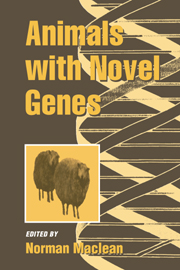6 - Large transgenic mammals
Published online by Cambridge University Press: 21 October 2009
Summary
Introduction
The possibility of expressing foreign genes in mammals by gene transfer has opened new dimensions in the genetic manipulation of animals. The basic techniques of gene transfer were developed in mice, which have been most extensively used in such experiments because they are ideal for studying gene expression during development and for establishing animal models of carcinogenesis and other diseases. Additional applications include analysis of mutations and the use of the transgene as a genetic marker (Jaenisch 1988).
Only a few years after the first successful gene transfer into mice, the new technique was used with farm animals, offering the prospect of completely new breeding strategies and other novel applications. However, despite a decade of gene transfer experiments in farm animals, only a few applications have achieved fruition (reviewed in Wall et al. 1992). This is mainly because of fundamental experimental difficulties with these species. In comparison with mice, farm animals have very long generation intervals and the time scale of a transgene project is thus extremely prolonged (Brem 1988, 1989). Naturally this problem is also experienced in conventional breeding programmes, but the major advantage of gene transfer is that significant advances can be made in one generation, whereas conventional breeding techniques require several.
Among the theoretically possible techniques of transferring genes, the only one successfully applied to farm animals so far is microinjection of DNA. Researchers have been rather reluctant to perform gene transfer experiments using retroviral vectors due to the slight risk of recombination with wild-type viruses.
- Type
- Chapter
- Information
- Animals with Novel Genes , pp. 179 - 244Publisher: Cambridge University PressPrint publication year: 1995
- 1
- Cited by



